| |
Teaching independent performance from the
beginning
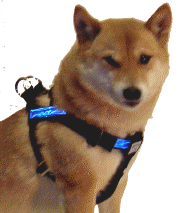 When
Raelene Koerber, a professional dog trainer, returned to Australia from Japan in 2002, she was
enthusiastic about the use of a harness and long-line in the introduction of dogs to agility When
Raelene Koerber, a professional dog trainer, returned to Australia from Japan in 2002, she was
enthusiastic about the use of a harness and long-line in the introduction of dogs to agility
training and in retraining 'velcro' dogs and handlers to work further away from each other.
Maisie Griffiths and Jennifer Hendriks took a series of lessons with her and share their
experiences and techniques.
(Note: You will need Windows Media
Player installed to be able to
play the video clips (or an alternative movie player that will play .wmv files).
Windows Media Player is usually installed as part of Internet Explorer; or you can
download it (free) from the
Microsoft web site)
Agility training using a harness and long-line enables a
task to be clearly communicated to a beginner dog or a 'Velcro' dog. This builds the dog's
confidence and speed by ensuring that he always succeeds.
In our own training and instructing, we had noted that
many handlers had trained their dogs initially to work close, then wished to change as their
training progressed, but found that the performance of their dogs had become heavily dependent
on their position in relation to, and their movement alongside, the dog. Some handlers we spoke
to felt that 'Velcro' behaviour was a factor in the temperament of their dog, but most felt
that distance skills would be developed when the dog had progressed to a more advanced level of
agility training. We thought it more likely that the handlers had trained Velcro
behaviour (i.e., the handler’s proximity to the dog and the obstacle became part of the dog’s
cue to perform an obstacle) and that if independent obstacle performance were trained from the
beginning there would not be a 'Velcro' issue.
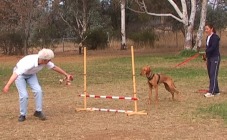 Introducing
harness training Introducing
harness training
We both favour the method of introduction of obstacles and the signalling system developed by
Jane Simmons-Moake, and we
thought that the harness method would work very well with this approach. We have used this
method with a number of dogs, but in this article we illustrate our points with reference to
Nash, a 6-month old Vizsla belonging to Maisie and Bao Bao, a Sharpei, who had been branded
‘the ultimate Velcro dog’ and who belongs to our friend Karen Henderson.
With Nash, our aim was to use the puppy’s enthusiasm and
speed to train in a manner which maintained this drive and motivation and to ensure that 'play'
and 'training' were indistinguishable from each other. In the case of Bao Bao we wanted to
break the 'velcro' bond to enable her handler to develop a better range of course handling
strategies.
Before training started, the dogs needed to be happy with
wearing a close-fitting, light-weight harness and to have been exposed to fun, motivating
situations while wearing the harness — e.g. feeding, playing, going out in the car. They were
also familiarised with trailing a long-line (a horse lunging rein is good) in safe situations.
Agility harness training (or retraining) began in the
common way with the handler calling the dog over or through obstacles which are lowered (jumps)
or short (tunnels). (Video
clip 1: Initial luring with Nash on harness/line)
The training partner would restrain the dog from behind with the long-line, but would not
interact with the dog in any other way. The handler recalled the dog over or through the
simplified obstacle. Luring was OK in the early stages. The training partner let the long-line
run free through her hands when, and only when, the dog was doing what the handler asked. (The
partner may need to wear gloves to prevent friction burns.) She did not allow the dog to move
forward if the dog was heading in the wrong direction, but waited and gave the dog time to
think about what he needed to do to get to his handler and his reward. (Video
clip 2: Increasing lateral distance / sending to target)
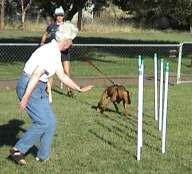 When the dog was going the right way, the partner released the long-line. The long-line did
several things: It promoted speed (through restraint) and prevented the dog from ever making a
mistake so that the reward ratio (play or food) was 100%. This, we observed, rapidly fostered
confidence and enthusiasm in our dogs since they were always right and we as handlers were
always very happy with them. We are sure the dogs thought 'What a wonderful game this agility
is!'. The speed of learning was sometimes staggering and the obvious engagement of the dog’s
brain was exciting to see. (Video
clip 3: Starting to work angled weave entries) We
have also found that ‘velcro dogs’, such as Bao Bao, who are already familiar with the
obstacles, progress particularly fast. (Video
clip 4: Bao Bao making a good choice off harness)
When the dog was going the right way, the partner released the long-line. The long-line did
several things: It promoted speed (through restraint) and prevented the dog from ever making a
mistake so that the reward ratio (play or food) was 100%. This, we observed, rapidly fostered
confidence and enthusiasm in our dogs since they were always right and we as handlers were
always very happy with them. We are sure the dogs thought 'What a wonderful game this agility
is!'. The speed of learning was sometimes staggering and the obvious engagement of the dog’s
brain was exciting to see. (Video
clip 3: Starting to work angled weave entries) We
have also found that ‘velcro dogs’, such as Bao Bao, who are already familiar with the
obstacles, progress particularly fast. (Video
clip 4: Bao Bao making a good choice off harness)
 We progressed - still on harness and line - by changing the angle or distance of the dog, then
of the handler. We imagined a clock face around the obstacle and trained from every ‘hour’. We
trained standing still, moving and at varied distances from the dog. We increased the height,
length, curve, etc. of the obstacles as appropriate for the dog. We only made one change each
run and we worked towards moving to either side of the obstacle at varying distances, then to
running by the obstacle, and finally to sending over/through the obstacle, initially to a
baited target. The handler ensured that she always started her dog with her signal/cue not with
her forward body movement. (Video
clip 5: Simple sequence on harness)
We progressed - still on harness and line - by changing the angle or distance of the dog, then
of the handler. We imagined a clock face around the obstacle and trained from every ‘hour’. We
trained standing still, moving and at varied distances from the dog. We increased the height,
length, curve, etc. of the obstacles as appropriate for the dog. We only made one change each
run and we worked towards moving to either side of the obstacle at varying distances, then to
running by the obstacle, and finally to sending over/through the obstacle, initially to a
baited target. The handler ensured that she always started her dog with her signal/cue not with
her forward body movement. (Video
clip 5: Simple sequence on harness)
When it was clear that our dogs understood their task
wherever we were, we tried a run off-harness. If our dogs made a mistake, we clipped the line
back on immediately and repeated the exercise until we were sure the dogs knew their task.
(Video
clip 6: Simple sequence off harness)
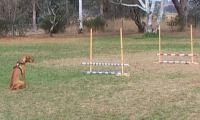 Conclusions
Conclusions
We have found the harness to be particularly useful in early weave training using a channel
method and in introducing the dog to independent weave entries. We are also using it
successfully with simple two or three obstacle sequences, calling off, etc.
Like all methods, this may not work with all dogs, such
as those who are bothered by the harness or by the proximity of the training partner. With a
young dog who is beginning agility, we would also be training the essential foundation skills
of waits, targeting, working right and left, back leg awareness, contacts, etc., separately
from harness work.
Our initial training with a harness was not intended
specifically to train the obstacles, but to communicate to the dog that there is a task to do
when his handler directs him, and to show him how to read his handler’s directions and to build
his confidence and speed by ensuring that he always succeeds in this task. In starting our
dog’s agility training in this manner, we believe we are clarifying the dog’s role as performer
and the handler’s role as director in the team effort. In other words, we are laying down the
ground rules for playing agility and providing a solid foundation for more advanced skills.
For more information on harness
training,
email Maisie Griffiths on maisie.g@bigpond.net.au
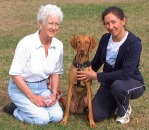 About the authors...
About the authors...
Maisie Griffiths and Jennifer Hendriks are instructors at the ACT Companion Dog Club
in Canberra, Australia. Maisie’s Vizsla, Maggie, has retired from agility competition, but
still enjoys 'demonstrating' to the beginner dogs and their handlers. Jennifer competes with
her Border Collie, Arie. Both Maisie and Jennifer train with Nash (now 15 months) as Jennifer
will handle him in trials later. Their main agility interest is in the complexities of training
and teaching.
| |
|